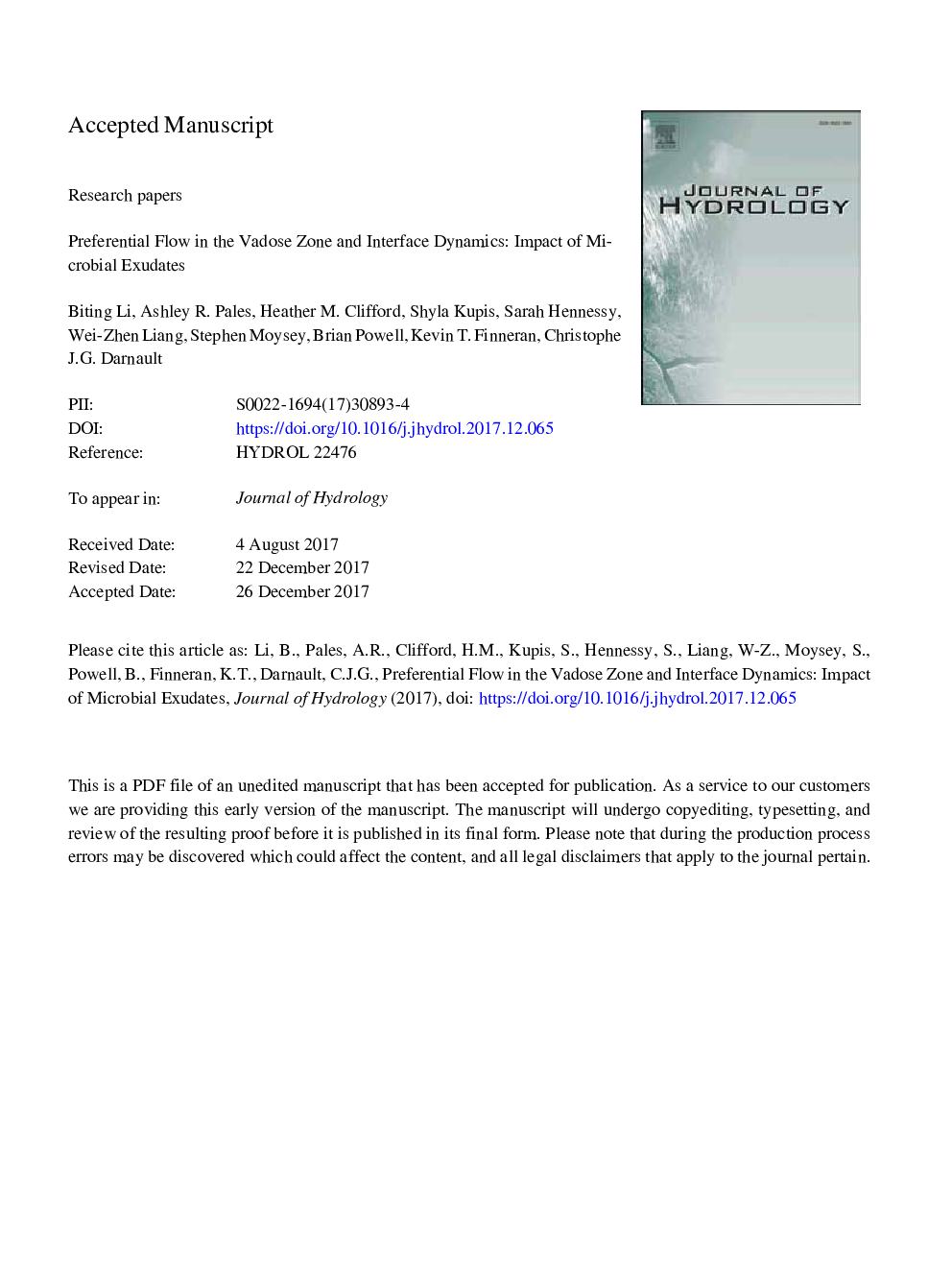| کد مقاله | کد نشریه | سال انتشار | مقاله انگلیسی | نسخه تمام متن |
|---|---|---|---|---|
| 8894967 | 1629896 | 2018 | 62 صفحه PDF | دانلود رایگان |
عنوان انگلیسی مقاله ISI
Preferential flow in the vadose zone and interface dynamics: Impact of microbial exudates
ترجمه فارسی عنوان
جریان ترجیحی در ناحیه رهوز و پویایی رابط: تاثیر عصاره های
دانلود مقاله + سفارش ترجمه
دانلود مقاله ISI انگلیسی
رایگان برای ایرانیان
کلمات کلیدی
موضوعات مرتبط
مهندسی و علوم پایه
علوم زمین و سیارات
فرآیندهای سطح زمین
چکیده انگلیسی
In the hydrological cycle, the infiltration process is a critical component in the distribution of water into the soil and in the groundwater system. The nonlinear dynamics of the soil infiltration process yield preferential flow which affects the water distribution in soil. Preferential flow is influenced by the interactions between water, soil, plants, and microorganisms. Although the relationship among the plant roots, their rhizodeposits and water transport in soil has been the subject of extensive study, the effect of microbial exudates has been studied in only a few cases. Here the authors investigated the influence of two artificial microbial exudates-catechol and riboflavin-on the infiltration process, particularly unstable fingered flow, one form of preferential flow. Flow experiments investigating the effects of types and concentrations of microbial exudates on unstable fingered flow were conducted in a two-dimensional tank that was filled with ASTM C778 graded silica sand. The light transmission method (LTM) which is based on capturing the light intensity transmitted through a sand-water system and then converting it into degree of water saturation was used to visualize and characterize the flow of water in porous media as well as to image and measure the spatial and temporal distribution of water in porous media. Flow patterns, vertical and horizontal profiles of the degree of water saturation of the fingers, as well as measurements of the fingers dimension (width), number, and velocity were determined using the light transmission method. Interfacial experiments exploring the influence of microbial exudates on the wettability behavior of water were performed by measuring the contact angle and the interfacial tension of the (solid)-gas-microbial exudate solution systems. Unstable wetting front generating fingered flow was observed in all infiltration experiments. The experimental results showed that the microbial exudate addition affected the infiltration process, as the measurements of the degree of saturation profiles and widths of the fingers differed from those of the control NaCl solution. These differences may be due to an improved water holding capacity in the presence of the microbial exudates. The lowest catechol solution concentration (10â¯Î¼M) produced the largest finger width (9.69â¯cm) among the tested catechol solution concentrations and all the other solutions including the control solution (7.24â¯cm). Moreover, the wettability of the medium for the catechol solution increased with an increase in concentration. The highest riboflavin solution concentration (1000â¯Î¼M) generated the highest finger width (7.75â¯cm) among the tested riboflavin solution concentrations. However, the wettability of the medium for the riboflavin solution decreased with an increase in concentration. Our study demonstrated that the microbial exudates which are biochemical compounds produced and released by microbes in the environment are capable of influencing the soil infiltration process. The results of this study also demonstrated that the influence of the contact angle expressed as (cosθ)1/2 should be integrated in the scaling of the finger dimension, i.e., finger width, when the Miller and Miller (1956) scaling theory is applied for the hydrodynamic scaling in porous media.
ناشر
Database: Elsevier - ScienceDirect (ساینس دایرکت)
Journal: Journal of Hydrology - Volume 558, March 2018, Pages 72-89
Journal: Journal of Hydrology - Volume 558, March 2018, Pages 72-89
نویسندگان
Biting Li, Ashley R. Pales, Heather M. Clifford, Shyla Kupis, Sarah Hennessy, Wei-Zhen Liang, Stephen Moysey, Brian Powell, Kevin T. Finneran, Christophe J.G. Darnault,
